5 Trends: How to Turn Uncertainty into an Advantage

Over the past few years, we’ve watched structures that were once reliable destabilize. Change is inevitable and history is full of periods of major disruptive change. This time, though, is different — a global pandemic has led the whole world to suddenly change the way it works and lives. While many of the changes we’re experiencing today were in process pre-pandemic, they came on extraordinarily quickly, leaving companies scrambling to adapt to fundamentally new ways of working.
For example:
- Consumer buying has shifted online (even for B2B buyers).
- Competitor sets are changing as entry into new markets is easier.
- Corporate longevity continues to decline as disruption is increasingly common.
- Supply chains are more complicated with international instability and direct-to-consumer growth.
- Digital transformations are continually prioritized but hard to execute.
These shifts have caused three major business challenges we see our customers dealing with every day:
- Strategic planning is no longer a once-a-year effort. It must be continuous and, in turn, companies need access to real-time data, both on business performance and end-customer sentiment.
- Companies have to do new things. This includes moving sales from online to direct to consumer, influencing end-consumers through entirely different channels, adjusting supply chains to be more dynamic, and handling disruption and uncertainty. All of these activities require new skills and capabilities.
- There is a major overlap across what companies are looking to get done. This is a result of many industries changing at the same time, requiring similar (if not the same) skills and capabilities. In parallel, the number of people who are capable of doing the work that needs to be done remains relatively stagnant.
These challenges have made one thing clear: The rapid rate of change today requires a new operating model for companies to adapt in real time and turn uncertainty into an advantage.
All of this is to say that it was an important moment for Catalant to host our October 2022 Executive Strategy Session. We gathered over 50 C-level and SVP-level business strategists including Catalant customers, advisors, and Experts to discuss how to turn widespread uncertainty across all sectors and areas of the market into an advantage, and which strategies to deploy to come out on top.
5 Trends: How to Turn Uncertainty into an Advantage
Our customers use Catalant’s Expert Marketplace to get thousands of strategic projects done a year. Data from the platform explain how companies have adapted to change nimbly and successfully since the pandemic began. The story that this data tells over time, and Catalant’s resulting perspective, are informed by working with hundreds of large companies (primarily VP+ leaders at Fortune 500, Operating Partners at global private equity firms, and Partners/MDs at global consulting firms) that use our platform to get strategic work done.
Catalant has an exclusive view into where markets have been, where markets are headed, and how companies will continue to use uncertainty as an advantage. Here’s a look at five of these trends we shared at the Executive Strategy Session.
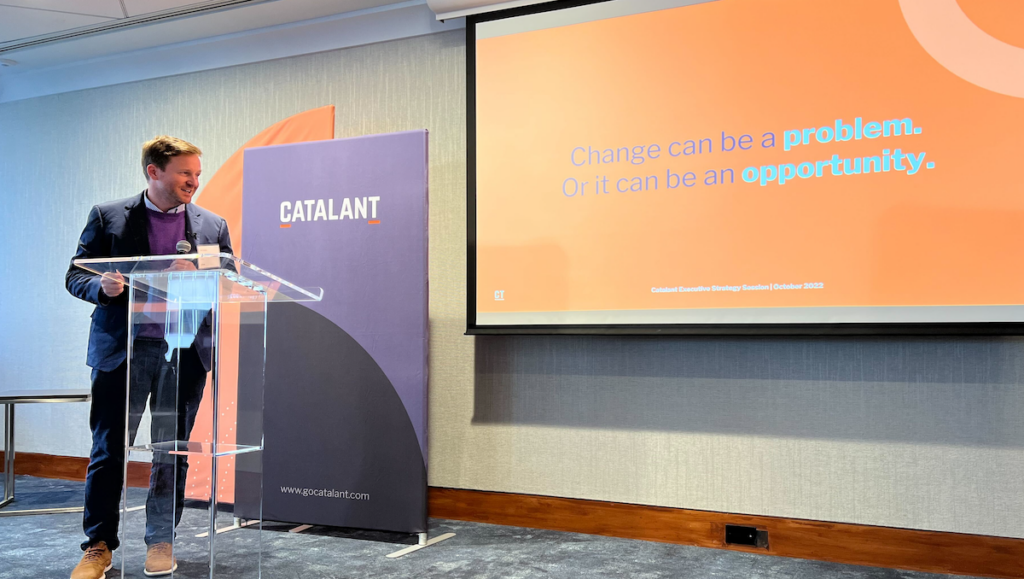
1. Mergers and acquisitions picked up steam in 2020.
At the end of 2020, we began to see mergers and acquisitions among companies that were looking to enter new markets and compete with new competitors. This was not just tied to PE firms; indeed, corporate development and strategy leaders were using independent consultants more than ever before for due diligence ahead of acquisitions across new sectors. The volume of M&A projects picked up steadily in Q4 of 2020 and continued to grow, peaking in Q3 of 2021. Much of this relates to companies needing to bring new capabilities in-house — and M&A is an effective way to do so.
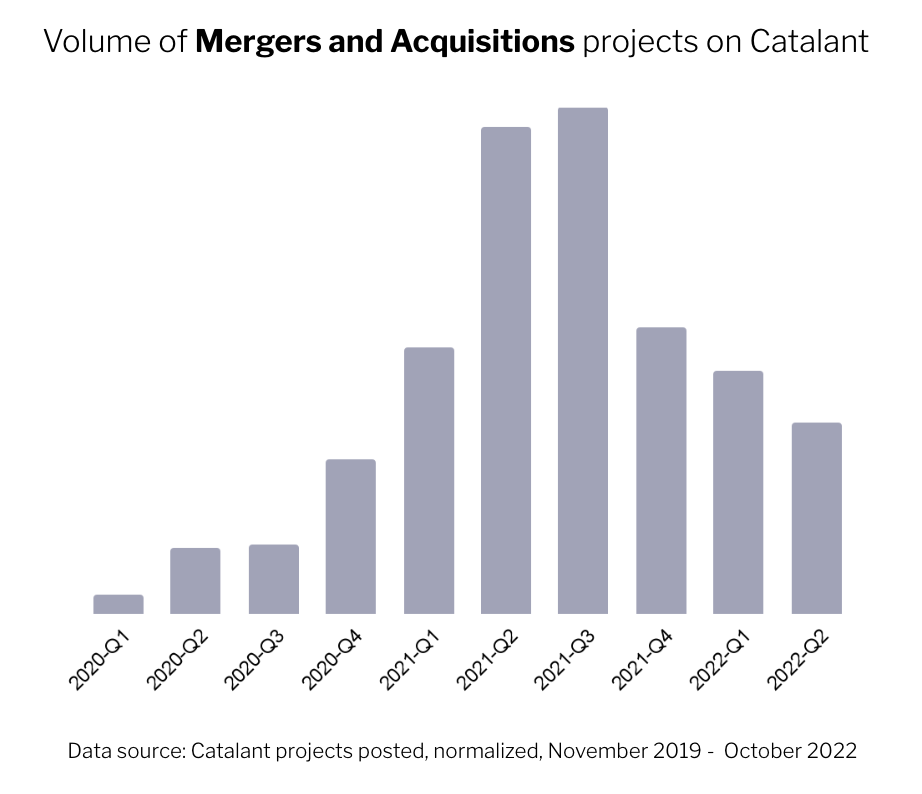
2. Supply chain management has been a consistent priority, though the reason has shifted.
Supply chain management has been and remains a priority. Over the past few years, supply chains have been top of mind for organizations across all industries directly due to the pandemic.
Today, there’s a more prominent reason supply chain management remains a priority — the cross-industry shift to direct-to-consumer models. Many of our clients have a critical need to directly engage with and sell to individuals as a result of new consumer behaviors and expectations. And this has major supply chain implications. As our data shows, access to supply chain expertise continues to be a priority at the most senior levels of organizations.
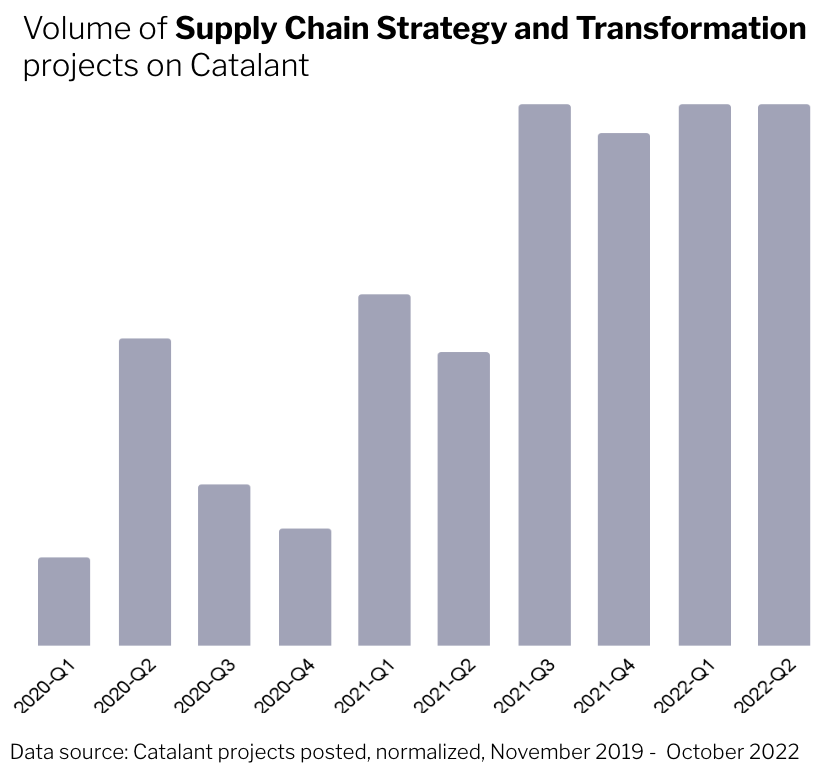
The number of market research projects on Catalant has increased 50% year-over-year, which largely correlates directly with the rise in supply chain changes. In most cases, this was due to the need to better understand consumer sentiment and shifting markets while at the same time adapting supply chains to deliver to them.
3. In the second half of 2021 organizational efficiency became increasingly important to leaders.
We’ve also watched companies struggle to hire talent and create capacity since the start of the pandemic. In particular, there has been a push for two things:
- Human resources strategy and transformation: Companies have looked to redesign their workforce, consider new methods of retention, and, in many cases, establish new ways of thinking about their workforce.
- Do more with less: Back in 2020 doing more with less was about learning how to operate in a world where organizations couldn’t fill capacity. But in 2022, companies realize they must be more efficient overall due to new resource constraints and the need to be prepared for any market dynamics that are on the horizon.
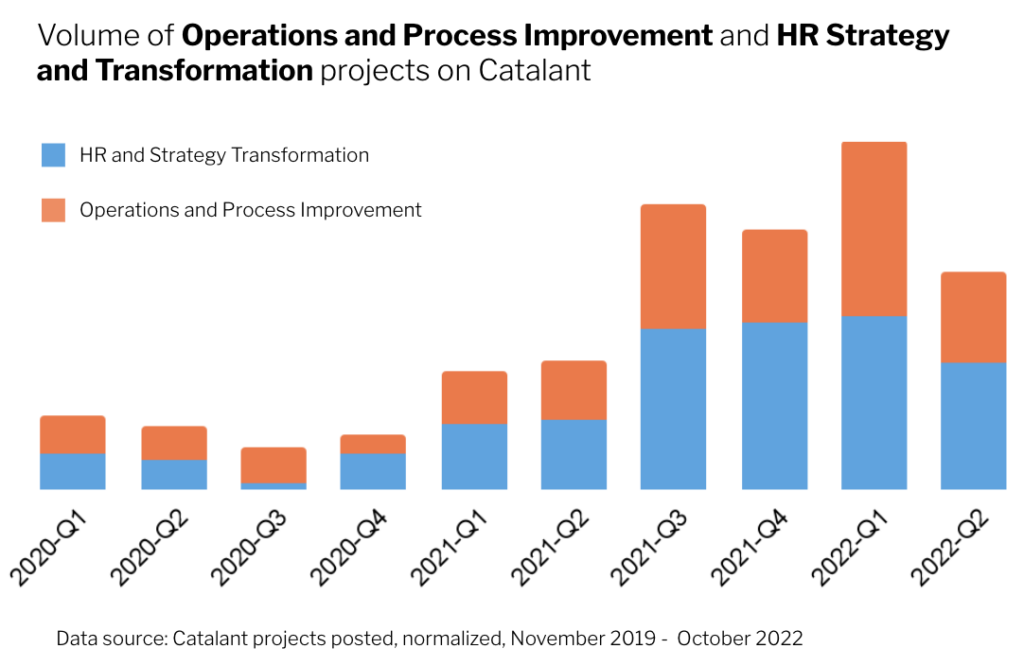
These are the reasons why companies are focused on organizational design and efficiency today — it allows them to retain talent while filling skill gaps with flexible resources.
4. Strategic planning and resourcing are always “on.”
Prior to COVID-19, strategic planning was a cyclical process. Data shows there was an uptick in strategic planning projects in the second half of a company’s fiscal year and the category would decline until the following year. But today, strategic planning needs to be “on” at all times — which is why we see more consistent strategic planning projects throughout 2021 and 2022. Many of our clients have told us that today, they think about transformation and strategy as one and the same.
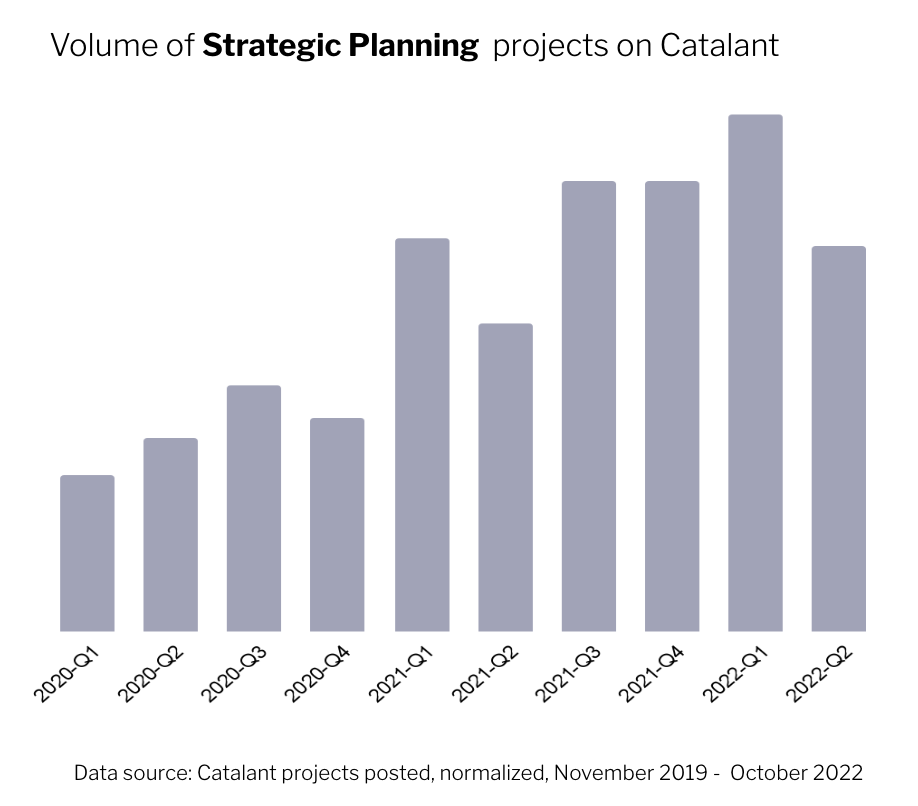
There’s also been an increase in technical assessment projects. In fact, on Catalant, the number of technical assessment projects posted to our platform doubled between Q4 2021 and Q1 2022. Companies are identifying the need for real-time access to data to inform their quickly-evolving strategies. Pair this with resource constraints and there’s a real need to find efficient subject-matter-expertise to help implement new technical solutions.
5. Agility is critical when turning uncertainty into an advantage more so today than ever before
To harness today’s vast and inevitable uncertainty, adjust your operating model to be adaptive, flexible, and dynamic — in other words, embrace business agility. Across the Catalant data we reviewed in the above sections, what stands out most to me is how important it is to be prepared to act with agility and react to ongoing changes dynamically.
The sense of mounting uncertainty that pervaded the pre-Covid years, due to disruption and fast-changing consumer expectations, has exploded during the pandemic into something almost existential. The future, always unclear, has never been so unknown. The essence of agility is navigating these fundamental transitions without plunging into free fall. Agility resolves the ambiguity that arises from existential uncertainty. It consists of the courage to ask hard and essential questions, and the skill to guide those inquiries toward the formation of flexible strategic directions.
Insead
Are you ready to embrace uncertainty?
The only thing we can be certain of is there is no certainty. To use change and uncertainty as an opportunity and advantage, your organization must operate flexibly. The companies that choose not to adapt to the times won’t:
1. Be able to react to the rate of change.
2. Have the data they need to inform business decisions.
3. Be able to access the right people to deliver the results they need.
With an agile and flexible approach, your organization will be able to adapt in real time and optimize your strategy so it aligns with current market dynamics. You’ll also have access to the precise talent and skill sets that you need the moment you need them, and be prepared to use change as an opportunity for growth.
Learn more about how Catalant can help your organization embrace uncertainty and use change as an advantage.
Let’s TalkRelated Articles
Share Article












